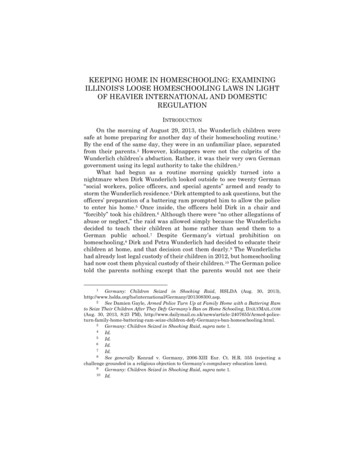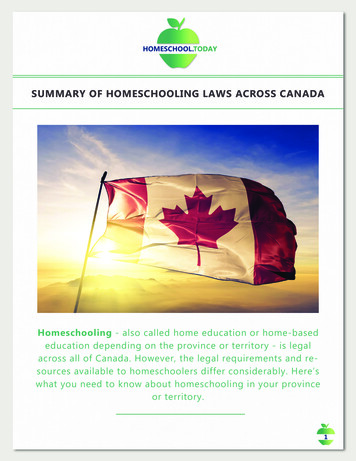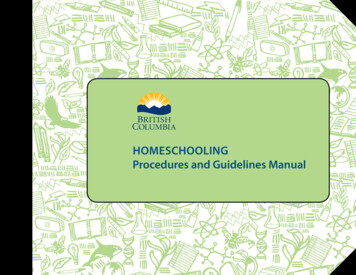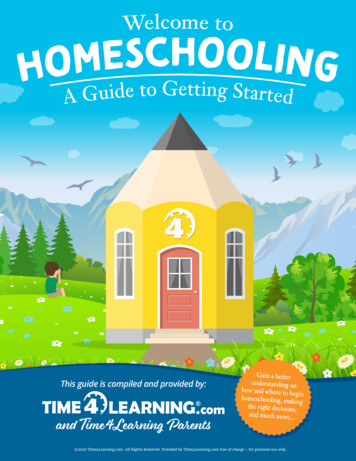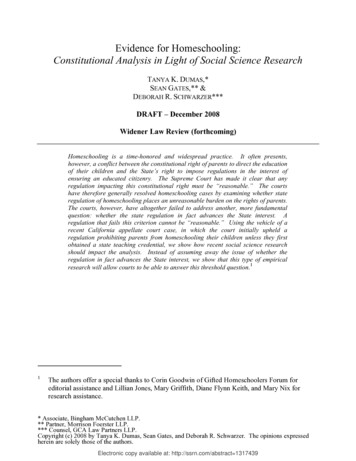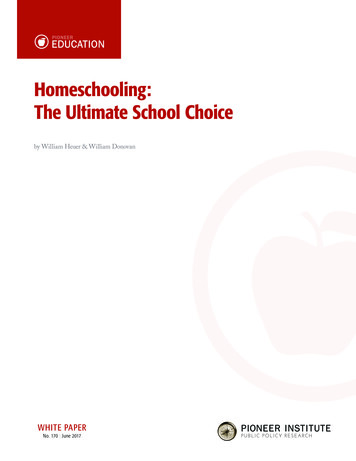
Transcription
Homeschooling:The Ultimate School Choiceby William Heuer & William DonovanWHITE PAPERNo. 170 June 2017
PIONEER INSTITUTEPioneer’s MissionPioneer Institute is an independent, non-partisan, privately funded research organization that seeks to improve the qualityof life in Massachusetts through civic discourse and intellectually rigorous, data-driven public policy solutions based on freemarket principles, individual liberty and responsibility, and the ideal of effective, limited and accountable government.This paper is a publication of Pioneer Education, which seeks to increase the educationoptions available to parents and students, drivesystem-wide reform, and ensure accountabilityin public education. The Center’s work buildson Pioneer’s legacy as a recognized leader in thecharter public school movement, and as a champion of greater academic rigor in Massachusetts’elementary and secondary schools. Current initiatives promote choice and competition, schoolbased management, and enhanced academic performance in public schools.Pioneer Public seeks limited, accountable government by promoting competitive delivery ofpublic services, elimination of unnecessary regulation, and a focus on core government functions. Current initiatives promote reform of howthe state builds, manages, repairs and finances itstransportation assets as well as public employeebenefit reform.Pioneer Health seeks to refocus the Massachusetts conversation about health care costs awayfrom government-imposed interventions, towardmarket-based reforms. Current initiatives includedriving public discourse on Medicaid; presenting a strong consumer perspective as the stateconsiders a dramatic overhaul of the health carepayment process; and supporting thoughtful tortreforms.Pioneer Opportunity seeks to keep Massachusetts competitive by promoting a healthy businessclimate, transparent regulation, small businesscreation in urban areas and sound environmental and development policy. Current initiativespromote market reforms to increase the supply ofaffordable housing, reduce the cost of doing business, and revitalize urban areas.Pioneer Institute is a tax-exempt 501(c)3 organization funded through the donations of individuals, foundations and businessescommitted to the principles Pioneer espouses. To ensure its independence, Pioneer does not accept government grants.
HOMESCHOOLING : THE ULTIMATE SCHOOL CHOICETable of ContentsExecutive Summary 4History 4How Many Are There? 6Who & Why 8Demographics 9Diversity 10The Hybridization Of Homeschooling 11The Cost of Homeschooling 12Federal Policy Impact 12Summary/Conclusions 13Recommendations 153
HOMESCHOOLING : THE ULTIMATE SCHOOL CHOICEExecutive Summarythe universal tenet of homeschoolers is the importance ofparental choice and the conviction that parents are bestequipped to make the educational decisions that affect theirchildren.Although many may be surprised at the growth of homeschooling during the past few decades, the real surprise is probably how that growth happened and that it continues. Homeschool advocates and practitioners have succeeded despite alack of funding, recruiting efforts, publicity, and grant money from philanthropic billionaires. Meanwhile they’ve facedopposition from the National Education Association (NEA),obstacles imposed by individual school districts and variousstate restrictions, regulations, and requirements. There is alsolittle if any professional development for parent-instructorsand virtually no future career path (or pensions) for those parents. Systemically, there is a lack of institutional knowledgewith which to keep the homeschooling movement going forward.HistoryThe notion that modern homeschooling harkens back to theera before compulsory education, when “schooling” occurredwhen an itinerant schoolmaster arrived in town and childrenlearned basic reading and “cyphering” from their parents, is asimplistic one. In those days most children simply followed intheir parents footsteps: girls would learn how to run a household and boys would take up the occupation of their father.This model of homespun homeschooling was based on familynecessity and schooling occurred by happenstance. Today’shomeschooling is not a revival of the past but a conscious lifestyle choice influenced by many factors.Other alternatives to traditional public school have encountered some of these same impediments, yet homeschooling hassurvived and prospered over the past half-century in the faceof all these challenges.Homeschooling as the ultimate in parental choice also epitomizes the concept of local control of education. Since educaUnlike private, parochial, and even charter schools, there is notion is not mentioned in the U.S. Constitution, the text of themarketing to entice parents to homeschool. The homeschool10th Amendment effectively places it in the hands of the states:ing way of life often originates via word“The powers not delegated to the Unitedof mouth and the old-fashioned way: oneStates by the Constitution, nor prohibitedToday’s homeschooling isclient at a time. Social networking, homesby it to the states, are reserved to the stateschooling blogs, and the abundance of hownot a revival of the past but respectively, or to the people.” Even thoughto books authored by homeschoolers alsohomeschooling has been legal in all 50a conscious lifestyle choicehave helped parents understand the realistates since 1993, states have attempted toties of a homeschool lifestyle.influenced by many factors. exert local control by establishing a mishmash of rules and regulations for homesThis paper will attempt to elucidate somechooling families.of these issues by reviewing a brief history of homeschooling,the challenges associated with defining and counting homeschoolers, the predominant reasons for homeschooling, andthe critical role parental choice plays in the decision to homeschool.While 13 states have homeschooling statutes and 10 statesrequire or permit homeschoolers to function as private schools,11 states require no notification that a family is homeschooling.1 In five states (including Massachusetts) homeschoolingis conducted under the “otherwise instructed” provision of thecompulsory attendance statute with no explicit mention ofhomeschooling. No state mandates that homeschool parentshave a college degree.There is no typical homeschooler or homeschooling family.The “one size fits all” model that has characterized traditionalpublic schools has been anathema for homeschoolers as theyformulate individualized learning plans for each of their children. Their method is not a scalable package in the conventional sense, but rather a proliferation of unique agendas customized to meet the needs of the individual student.There are 14 states that permit part-time homeschoolingat a public school, seven prohibit it, and the rest leave it upto individual school districts. Twenty-three states (plus theDistrict of Columbia) require that homeschoolers be tested.2 Twenty-two states allow homeschoolers to participate inextracurricular activities in their local school, seven prohibitthose activities, and the remainder leave it up to the district.3While 21 states ban homeschoolers from participating in highschool sports 19 permit it (and five more grant permission ifthe homeschooler is participating in dual enrollment). Fivestates (including Massachusetts) permit athletic participationwith district approval.While the tutorial aspects and advantages of homeschoolingare difficult to replicate in the public system because they areexpensive, there are many innovative components of homeschooling that could be replicated in the traditional schoolenvironment.Homeschooling is a viable alternative for the many studentsand their families who wish to opt out of traditional publicschools. Regardless of a family’s rationale for homeschooling,4
HOMESCHOOLING : THE ULTIMATE SCHOOL CHOICEAs the first state to enact a Compulsory Attendance statutein 1852, Massachusetts mandated schooling by requiringevery city and town to establish a public school for all childrenbetween the ages of 8 and 14. This schooling was required tobe in session for a minimum of 12 weeks each year with six ofthose weeks being consecutive.in advance by the superintendent or the school committee."Today, Massachusetts and Rhode Island are the only two“approval” states in the country, meaning that an educationplan with an assessment process must be submitted to thedistrict and be approved before homeschooling can begin.7In most cases, the school committee delegates approval tothe superintendent, who is responsible for every child in thedistrict under the compulsory attendance statute. In Massachusetts, since the superintendent has responsibility forall students and the approval process also applies to privateschools, homeschoolers are not being singled out by needingto be approved.The architect of this revolutionary concept was Horace Mann,known as the “Father of American Education” as well as the“Father of the Common School.” However, historian MiltonGaither notes: “Ironically, some of the very people pushing sostrongly for common schools that would raise the masses up tothe level of the middle-class Protestant consensus were tutoring their own children at home out of a fear that these verymasses would corrupt their own kids. One such individual wasHorace Mann himself, whose wife Mary taught their threechildren at home even as he stumped the country preachingthe common school.”4While the 1922 US Supreme Court decision in Pierce v Society of Sisters8 ruled that compulsory attendance statutes couldnot restrict students to attending only public schools, it wasWisconsin v Yoder,9 a decision handed down 50 years later thatfurthered the argument that parents have the ultimate responsibility to determine how best to educate their children. InYoder, the Supreme Court agreed with several Amish familieswho refused to send their children to school beyond eighthgrade due to their religious beliefs. A basis was being established to support exceptions to traditional schooling.Even more ironic was Horace Mann biographer JonathanMesserli noting that,“ From a hundred platforms, Mann had lectured that theneed for better schools was predicated upon the assumption that parents could no longer be entrusted to performtheir traditional roles in moral training and that a moresystematic approach within the public school was necessary. Now as a father, he fell back on the educationalresponsibilities of the family, hoping to make the firesideachieve for his own son what he wanted the schools toaccomplish for others.”5In the latter part of the 20th century, a confluence of eventsset the stage for the surge in homeschooling. Contemporary homeschooling can trace its roots to the 1970s and ’80s.Although a number of education reformers at that time werehighly critical of publicschooling, two wereHorace Mann’s hypocrisy ofnotable for becomingmaintaining parental choiceconvinced that reformwas not the answerfor himself while advocating aand they became thesystem of public education forpioneers of the homeschooling movement.others seems eerily similar toThis hypocrisy of maintaining parental choice for himselfwhile advocating a system of public education for others seemseerily similar to the mindset that is so common today: Manypeople of means who can choose to live in districts with better schools or opt for private schools resist giving educationalchoices to those less fortunate.Dr. Raymond Moorethe mindset that is so commonwas appalled by Caltoday: Many people of meansifornia’s attempt towho can choose to live inlower the compulsory attendance age todistricts with better schools ortwo years and nineopt for private schools resistmonths. His researchon the negative effectsgiving educational choices toof schooling on youngthose less fortunate.children resulted in thepublication of BetterLate Than Early in 1975,10 his advocacy of homeschooling, andhis prominence as an early hero of Christian homeschoolers.Since the advent of the compulsory attendance statute in Massachusetts, a number of key court decisions helped pave theway for the homeschooling we experience today. In 1893, theCommonwealth v Roberts 6 decision found that state law permitted instruction “by the parents themselves, provided it isgiven in good faith and sufficient in extent.” Six years later,the “otherwise instructed” wording appeared for the first timewhen the relevant section of state law was changed to read:“but if such a child has attended for a like period of time aprivate day school approved by the school committee or if suchchild has been otherwise instructed for a like period of time inthe branches of learning ”Then, in 1913, upon petition from the Massachusetts SchoolSuperintendents Association for legislation relative to schoolattendance and the employment of minors, the statute’s wording was changed to "otherwise instructed in a manner approvedMeanwhile, John Holt, after writing How Children Fail 11 andHow Children Learn,12 came to the conclusion that schoolscouldn’t be reformed. He became a homeschool proponent5
HOMESCHOOLING : THE ULTIMATE SCHOOL CHOICEand coined the term “unschooling” to reflect the child-centered approach he advocated. In 1977, while working inBoston, he established Growing Without Schooling, the firstnational homeschooling newsletter and essentially became thespokesman for secular homeschoolers.on these essentials: the district may request a proposed curriculum (along with the hours of instruction in each of theproposed subjects) and may have access to materials being used(but only to determine the type of subjects and grade level forcomparison purposes). Instruction shall be equal in “thoroughness and efficiency, and in the progress made therein,as that in the public school of the same town ” The districtmay consider the length of the homeschool year and the competency of the parents (but neither certification nor a collegedegree is required). An assessment process should be specifiedin the education plan, although alternative means of evaluating a child’s progress, such as periodic progress reports ordated work samples, may be substituted for the formal testingprocess.Positive publicity during these years was sporadic but it didbring homeschooling to theattention of the public. WhenThe legal aspects ofGrant Colfax, a homeschoolerwho raised goats on his family’shomeschooling infarm in California, was acceptMassachusetts areed to an Ivy League institutionbased on severalin 1983, it made national headlines: “Goat Boy Goes To Harsignificant court casesvard.”13 Holt’s 1981 appearancebrought during theseon the Phil Donahue Showgenerated 10,000 letters seekformative years ofmore information on themodern homeschooling. inghomeschooling phenomenon.14Meanwhile support groups andhomeschooling organizations were also starting to come intoexistence.A decade later, the SJC’s Brunelle Decision (Brunelle v LynnPublic Schools – 1998 17) affirmed the Charles ruling and alsodeclared that a home visit is NOT presumptively essentialto the protection of the Commonwealth’s interest in seeingthat children receive an education, and thus such visits maynot be required as a condition for approval. The SJC also tookthe opportunity to note that “teaching methods may be lessformalized, but the home setting may be more effective thanthose used in the classroom because the teacher-to-studentratio is maximized (the state) cannot apply institutionalstandards to this non-institutionalized setting.”The Home School Legal Defense Association (HSLDA),a national Christian-based organization founded in 1983,provides legal advocacy for homeschoolers. Throughout the1980s, statewide organizations such as the MassachusettsHome Learning Association (MHLA), which was establishedin 1987, were forming to assist families navigate homeschooling procedures in their respective states.Since Brunelle, there has been neither further legislation norsignificant court cases, and homeschooling continues to operate under the precedents set by these three decisions.The legal aspects of homeschooling in Massachusetts arebased on several significant court cases brought during theseformative years of modern homeschooling. In Perchemlides vFrizzle, a 1978 Superior Court decision, the superintendentof schools in Amherst was overruled in his rationale for disapproving an education plan submitted by a homeschooling family.15 The court specified that the district could not consider thelack of a plan identical to that of the public school, a lack ofsocialization, fear of setting a precedent, or the parents’ reason for wishing to homeschool. The latter factor clarified thatthe “otherwise instructed” provision in the Commonwealth’sstatute was not conditioned on religious beliefs, as had beenthe situation in prior national cases brought before the USSupreme Court.How Many Are There?There’s an old saying that is apropos to homeschooling: “Noteverything that counts can be counted, and not everything thatcan be counted counts.”Hardly any discussion“ Everything that can beof homeschooling iscounted does not necessarilycomplete without hearing the question, “Howcount; everything thatmanyhomeschoolerscounts cannot necessarilyare there?” In 1980,educational theorist andbe counted.”homeschooling advo— Albert Einsteincate John Holt answeredby replying “Nobodyknows, but I'd guess somewhere close to 10,000 families.”Two subsequent rulings by the Massachusetts Supreme Judicial Court (SJC) outlined the approval process and solidifiedthe manner in which homeschooling functions in the Commonwealth today. The Charles Decision (Care and Protection ofCharles, 1987 16) reaffirmed the approval process but cautioneddistricts that approval must not be conditioned on requirements that are NOT essential to the Commonwealth’s interestthat all children should be educated. It proceeded to expandNow, some 35 years later, the parents of over two million children in the United States believe education is too important tobe left to the educators, and are adhering to Holt’s philosophy(and the title of his seminal 1981 book): Teach Your Own.18Holt’s rough estimate of 10,000 held sway in the early1980s. Then significant growth kicked in. By the 1990s state6
HOMESCHOOLING : THE ULTIMATE SCHOOL CHOICEHow Many Homeschoolers are There? 802003200720122016* Estimates from NCES (note: 1980 represents “guestimate” from John Holt)education agencies (SEAs) recognized a steady increase inthe number of homeschoolers and they began collecting datausing estimates extrapolated from local district filing statistics. However, since there was no consistency in local filingrequirements or the monitoring of homeschoolers, the states’data was unreliable. In fact, by the mid-90s only three stateswere believed to have filing rates that could be considered closeto 100 percent accurate.19The latest figures published by the NCES (2012) estimated 1.8 million, 3.4 percent of all K-12 students, were beinghome-educated in the U.S.21 This is more than double thenumber that were being homeschooled when the NCES firstbegan collecting data in 1999, reflecting an annual increase of7 percent for most of the first decade. Meanwhile during thatsame time, public school enrollment was growing at less than1 percent per year.22Homeschooling is now legal in all 50 states and is not onlygrowing but flourishing. Currently, the primary source usedto calculate the number of homeschoolers in the U. S. is theNational Center for Education Statistics (NCES), part ofthe Institute of Education Sciences (IES), the independent,non-partisan arm of the U.S. Department of Educationresponsible for educational information, research, and statistics. Homeschooling statistics were first incorporated intoNCES reporting in 1999 using data from the parent segmentof the National Household Education Survey Program. Thatyear NCES estimated that there were 850,000 homeschoolers,about 1.7 percent of the U.S. student population between theages 5 to 17. By 2003, that number had increased to 1.1 millionhomeschoolers or 2.2 percent of all students. By 2007 it was1.5 million or almost 3 percent of all students nationwide.20While the remarkable homeschooler annual growth rate of7 percent was not sustainable, the most recent estimate of 3percent per year is still impressive.23 Even this lower growthfactor indicates that homeschooling easily surpassed the twomillion mark in 2016. Furthermore, even a slight increase inthe 1.8 million homeschoolers in 2012 means that for the firsttime, those being homeschooled exceeded the 2016 parochial school enrollment.24 With a continuing decline in privateschool enrollment 25 anticipated at least through 2026, homeschooling has become the country’s fastest-growing alternativeeducational option.As for Massachusetts, the Department of Elementary andSecondary Education (DESE) has published school and district profiles on their website covering over 30 years of dataand has incorporated homeschooling numbers since 2010.7
HOMESCHOOLING : THE ULTIMATE SCHOOL CHOICEDESE currently states that there are some 7,500 homeschoolers in the state.26 However, these counts are subject to the samevagaries as the national data estimates as they are self-reportedby school districts. AnnZeise, who has beenwriting and researching homeschooling familieshomeschooling issueswere often stereotypedfor several decades estias either right-wingmates that there are over28,000homeschoolconservative Christians orers in the Commonleft-wing progressive hippies. wealth.27 In addition, aBoston Magazine articleessentially disputes the homeschooling count for the city ofBoston as being under-reported by DESE by more than half.28On the other hand, pedagogues tend to homeschool to be freefrom the constraints of a “one size fits all” system that doesn’tutilize a developmental, child-centered approach to learning.Like ideologues, they also tend to have concerns about curricula but they either purchase secular curricula or use alternativeresources, modifying them as needed for each child.While it has been generally assumed that fundamentalistChristians make up the majority of homeschoolers, the NCESdoes not specifically track those numbers. However some ofthe earliest NHES data from the beginning of the 21st centuryindicated that 70 percent of homeschoolers had a non-religiousrationale as their prime reason to homeschool.31 In addition,data from the 2012 report shows a significant change in thereasons families choose to homeschool compared to reasonsthat were paramount just five years earlier. Although in 2007,36 percent of homeschoolers cited religious instruction as theirprime motivation; five years later that percentage fell by morethan half to 17 percent. “Environment in schools” had becomethe predominant reason for 25 percent of homeschoolers, and91 percent listed it as one of the reasons that was importantto them.32Ironically, as the question of how many homeschoolers was onthe verge of being resolved, the definition of what constitutes a“homeschooler” began to unravel. Throughout the latter partof the 20th century the definition of a homeschooler seemedfairly straightforward: a student not enrolled in the publicschool system whose family conducted his or her educationalprocess at home—or at least not in school.In addition to these shifts in rationale, a survey by Hanna33found that 47 percent of the families identified themselves asideologues, 25 percent as pedagogues, and a surprising 26 percent described themselves as both.Who & WhyIn the early days of contemporary homeschooling, homeschooling families were often stereotyped as either right-wingconservative Christians or left-wing progressive hippies. Later, sociologist Dr. Jane Van Galen coined the more charitableterms “ideologues” and “pedagogues” to describe homeschoolers based on their rationale for selecting home education andhow it was implemented.29This blurring of the lines may also be confirmed by a sociological study that coined a new terminology: “first-choice” and“second-choice” homeschoolers.34 The “first-choice” familyis in essence the traditional homeschooling family, viewinghomeschooling as a lifestyle and an integral part of a student’sgrowth.Despite their disparate philosophies on how and why theyhomeschool, both camps have been united in their belief thatparental choice in deciding to homeschool and the mannerin which their children are educated is an intrinsic right, onewhich should not be usurped by the state. Both types of homeschoolers emphasize that enhancing “family relationshipsbetween children and parents and among siblings” is a primemotivation for their choice.30 They also hold to the belief thatthe overall environment of traditional public school systemsis not conducive to the educational goals they have for theiroffspring.Homeschoolers Based On Their Rationale*Pedagogues25%Ideologues47%In general, ideologues tend to homeschool for religious ormoral reasons, believing that the public schools either cannot fulfill these goals or that the public system underminestheir family values via the curricula being taught. The content taught in public school science, literature, history, civics,and health classes often conflicts with a family’s beliefs. Thesefamilies may purchase faith-based curriculum packages thatreinforce their religious values.Both26%* B ased on survey by Linda G. Hanna8
HOMESCHOOLING : THE ULTIMATE SCHOOL CHOICE“Second-choice” homeschooling parents might be describedtax-supported local public school.as “pragmatic homeschoolers,”35 perhaps even “reluctantThis significant one-third turnover rate also means that manyhomeschoolers.” While these parents exhibit the same devomore children than originally thought have experienced sometion to finding what they consider the best educational optionshomeschooling, since the overall numbers need to compensatefor their children and exercising their right to parental choice,for replacing students each year as they cycle in and out of thethe key distinction is that this sub-set tends to view homeshomeschooling process depending on the changing needs ofchooling as a stop-gap solution to a school-based problem asthe students and their families.opposed to an overall family lifestyle. Their reasons are usuallythe oft-cited dissatisfaction with the environment or instructional methods at local public or private schools. Their shortDemographicsterm goal is to homeschool until they can reach their ultimateAlthough homeschooling families are far from homogeneousgoal: a better school situation for their child. This may meanwith regard to their approaches to education, some statisticseventually sending their child to a private school (which theydo show similarities among homeschoolers. As 90 percentmay not be able to afford right now), moving to better schoolof them live in two-parent households (about 20 percentagedistrict, finding an ideal special needs school, avoiding a perpoints higher than all U.S. students) they are three timesceived situation (often at the middle school or high schoolmore likely to have only one of their two parents working 38,level), re-entering the charter school lottery, etc. For the parwhich is not unreasonable considering one parent is usuallyent who shoulders the most responsibility for homeschooling,handling the education process on athere are almost always competingdaily basis.personal, professional or financial“Second-choice” homeschoolingA recent survey by Education Nextgoals (returning to the workforce,determined that 8 percent of thestarting a new business, returningparents might be described asto school to get an advanced degree)“pragmatic homeschoolers,”35. Their general public with school-agedchildren has participated in homesthat they are willing to sacrificereasons are usually the oft-citedchooling. Furthermore, 7 percent ofin the short term to support theirteachers with their own school-agedchild’s immediate and specific edudissatisfaction with the environmentchildren have also homeschooled atcational need.or instructional methods at localsome point.39At present there are no data idenpublic or private schools. Their short- Homeschoolers tend to live in largtifying the number of these secterm goal is to homeschool untiler families. More than 60 percentond-choice homeschoolers, but therecome from homes with more thanare indications that lend support tothey can reach their ultimate goal: atwo children, compared to 40 perthe premise that this trend exists.better school situation for their child. cent for all U.S. students. They’reSome 50 percent of homeschoolingroughly evenly distributed amongfamilies do not homeschool all theirthe nation’s regions, with the excepchildren; half of all homeschoolingtion of more homeschoolers in the South than in the Northfamilies send at least one of their other children to a private,east. Homeschoolers are somewhat more likely to reside incharter, or traditional public school.36 While sending a childrural rather than suburban areas; the percentage of urbanto a religious private school would be consistent with a family’shomeschoolers is similar to that of traditional students40. Asfaith-based educational rationale, other homeschooling parmentioned earlier, roughly half of homeschooling householdsents who opt for a traditional, charter, or non-religious privatesend one or more of their other children to a traditional school.school for one or more of their children would seem to havea pragmatic reason
This model of homespun homeschooling was based on family necessity and schooling occurred by happenstance. Today's homeschooling is not a revival of the past but a conscious life - style choice influenced by many factors. Homeschooling as the ultimate in parental choice also epito-mizes the concept of local control of education. Since educa-


